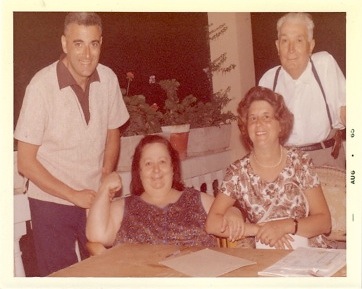
LINA PAGLIUGHI A TRIBUTE BY LUCIANO DI CAVE PART TWO

Let’s go now to the questions of my dear friend Rudi v.d. Bulck, so innocent, apparently, but very keen and interesting.
1 When did you first hear her? When did you first hear her live in the theatre?
What was / is the impact the voice had / has on you?
When I begun to collect records I was twelve years old and being still very young and not having much money at my disposal I bought them with the rhythm of on or two a month. One of the first records I possessed was the mad scene from Lucia di Lammermoor with Toti Dal Monte, a name that was already a legend. In 1938 I went with my parents to a performance of Rigoletto at Terme di Caracalla, with Toti Dal Monte, Galliano Masini and Mario Basiola. I must confess that I have only
a vague memory of that performance. Later I heard Toti in “La Sonnambula” in 1943 in a broadcast from Teatro La Fenice in Venice (with Ferruccio Tagliavini), but her voice had lost all
her charm. Already for many years, another “soprano leggero” was imposing herself in the theaters and from radio broadcasts: Lina Pagliughi.
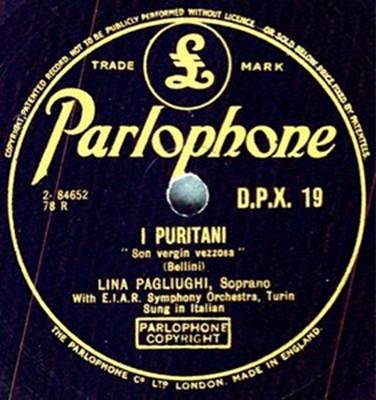
I listened to her, the first time on the radio and my interest increased every time I heard her on records or in those radio broadcasts. I hoped to see her name on the play bills of the Teatro Reale dell’Opera, but, as I have already said, she never sang there. We had to wait till 1941, the year in which I had my first, memorable experience of hearing a live performance of Lina Pagliughi. At the Teatro Adriano, in Rome, there was a concert entirely dedicated to Vincenzo Bellini, where the main interpreters were Pagliughi and Gabriella Gatti. The first sang the scene “Son vergin vezzosa” from i Puritani and, from la Sonnambula, the concertato “D’un pensiero” and the final scene, from “Ah! Non credea mirarti” to “Ah! Non giunge”, the latter sang, exquisitely, scenes from Norma, both with tenor Aurelio Marcato. To hear the voice of Pagliughi and to feel the so-called “lightening bolt” (whose effects, before her voice, never vaned, was something unique. The purity and the beauty of her voice united to a technique perfect and inconceivable in other sopranos of her time (with the exception of Mercedes Capsir, but at that time Capsir was no more young and she sang in Italy for the last time in 1943). I listened to a timbre sweet but not colorless, able to sing “Ah non credea mirarti” with a flawless line and to sparkle with a profusion of trills and high notes (E flats and a glorious final “F” in “Ah! Non giunge. She recorded “La Sonnambula”, complete, in 1953, but though her voice was still there, beautiful and pure, the sparkling of her golden days had gone.
I realized that her appearances in Rome were not very frequent, but, unexpectedly, a few months later, she sang “La Traviata” at theTeatro Brancaccio during a Summer season. My impressions of the first encounter were reinforced, but, to hear Lina Pagliughi live in a complete opera I had to wait till 1946, when I heard her at the Teatro Quirino in “La Sonnambula”, still able to sing like an angel and to lavish her famous high notes. I regret that, though listening to her many times from radio, I lost some of her best years.
She sang mostly in Northern Italy and I could listen to her “live” in 1946 and 1947 at the Teatro Adriano and the Teatro Quirino. At the teatro Valle, for a RAI broadcast, I listened to “L’Elisir d’amore” with Tito Schipa. Later I listened to a Lucia di Lammermoor in Turin and, in 1950 in Rovereto (Trento) in a concert with Tito Schipa. The last time I heard her in the flesh was at a concert at the Teatro Argentina in1954, where she sang in the “Missa Solemnis” by Beethoven.
2 Where would she be in your opinion compared to other singers in her repertoire?
I should place her at the top of the position, not only for the beauty of the voice and the excellence of her technique but for another reason: with the advent of “verismo” the so-called
“soprano leggeri or coloraturas” were no longer found pleasing and most of them were known as “mechanical nightingales”. In my opinion Amelita Galli Curci, though not renouncing the marvelous fireworks, traced a new line to release the light soprano from the simple role of agile performer and direct it towards a more human and rich understanding of greater sensitivity. Toti Dal Monte followed this line and Pagliughi, who had great admiration for both these singers conformed to this way. And their interpretations, although not yet so clearly marked as in the dramatic torment of Maria Callas, had already cut a division with the sopranos of the previous generations. But everything is obtained in steps and, if we may smile before the artificial and arabesque performances of Patti, Hempel and Galvany, we must understand that to pretend a different comportment from these singers in their era would be unnatural and anachronistic.
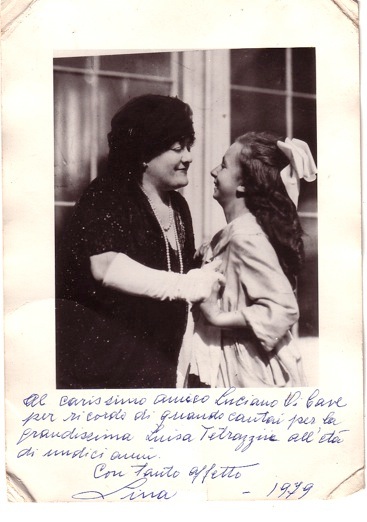
3 A discussion of her best recordings, greatest roles?
The answer to this question is not easy: her records, for the most part, are well recorded,
technically, but they don’t reproduce completely the essential qualities of Pagliughi, her
fluency, the delicacy of the colours of her voice. To understand better these endowments you
may address to the VICTOR recordings for the 78s and to the LPs, where, though no more in her
best form, the voice is caught more faithfully.
Let’us begin from the famous Rigoletto, called “the Pagliughi Rigoletto”, that has been
condemned or praised to the skies, according to the ideas of the various critics.
Don’t forget that this Rigoletto was the first electric recording of a complete opera and it was
released in 1928, when the electric recording was taking its first steps. Undoubtedly the 21
years old girl obtained wonderful results but the voice is still unripe. There are splendid
moments, the fluent “finale” of Caro nome, the astonishing Eflat in “Sì vendetta”, a great
musicality in “Lassù in cielo”. Don’t forget that this Rigoletto had a formidabile competitor in the
Columbia edition that could rely on three formidable names: Mercedes Capsir, Dino Borgioli and
Riccardo Stracciari.
Two years later she recorded for “La Voce del Padrone” the “Mad scene” from Lucia di Lammermoor, a great improvement in the voice and in the recording technique. Between 1932 and 1934, beginning her activity at EIAR, the national broadcasting station, she recorded a good number of arias and duets for Italian Parlophon. Some of these recordings are very good (Fra Diavolo, la Gazza ladra, Linda di Chamounix, Clo Clo), others,although her voice appears more refined and secure with respect to the recording of Rigoletto, suffer for an approximate artistic supervision: il Barbiere di Siviglia, Don Pasquale, la Sonnambula show a frenetic rhythm in the tentative to record every aria on a single side. (The German Parlophone had already recorded “Una voce poco fa” with Margherita Salvi and Margherita Carosio on two comfortable sides). For Parlophon Pagliughi recorded also four songs, one of which “Tu sei la mia regina” was recorded by Alessandro Ziliani for Voce del Padrone.
The CETRA recordings date from 1934 and, technically, show a great improvement with respect to Parlophons (not always). On my opinion the best are “Il Re O colombello”, Mignon “Io son Titania”, the Enlevement from Serraglio “Ah! Chi amando”, la Sonnambula “Ah non credea mirarti”, I Puritani “Son vergin vezzosa”, the aria fron the Golden Cockerel, the duet “Lassù in cielo” from Rigoletto with Alexander Sved, that is really a performance “by the book”. Lakmè contains many inaccurate moments and the high note at the end is not adequate to her fame, Falstaff and Guarany show very harsh recordings, the arias from Nozze di Figaro and Don Giovanni are released on a ten inch record (Don Giovanni is cut, Nozze di Figaro is too hurried). Subsequently these arias, with Lakmè, Elisir d’amore, Rigoletto (Tutte le feste) were re-issued in England on 12 inches records!
Pearl Fishers and William Tell offer good performances, “Qui la voce sua soave” from Puritani is too hurried, especially for the first part. When Callas recorded the aria for CETRA she was allowed to have two sides at her disposal. Semiramide, though suffering from a war-time recording, is very good, the same applies to the aria from Carmen.
We must speak, of course, of the complete “Lucia di Lammermoor”. A successful recording which held its positions in the catalogs till the advent of LP. It appeared again on microgroove
records and, after 1980 was issued on CD. Here, in some scenes, you can hear her wonderful flute notes (O gioia che si sente e non si dice-Mad scene).
In 1940, during her American tour, Pagliughi released some test-proofs for Victor. Only one, Il Carnevale di Venezia, was issued commercially, the others remained confined in the Victor Archives. They appeared for the courtesy of Mme Pagliughi who had received vinil copies of Il Carnevale di Venezia, Proch’s variations and Lo, here the gentle lark. Another song appeared later on an auction sale, “La Capinera / The wren – by Benedict). Perhaps other arias are present in the archives. These recordings are beautiful, even if it is clear that they are test-proofs and, as I have already said, her voice is caught almost perfectly.
In 1947 Pagliughi made her last 78 recordings with duets from Rigoletto with Alexander De Sved.
Pretty good recordings, still an Eflat in Sì vendetta (not so formidable as in the VDP records), a wonderful final duet.
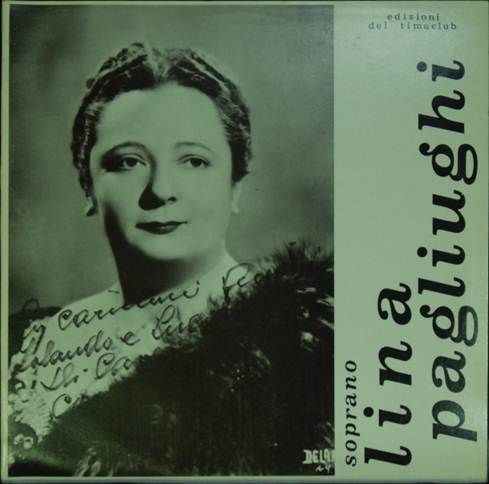
Let’s go to what I call the second part of her career. “Un giorno di regno”, “The Daughter of the regiment” and Falstaff offer a valid soprano, still able to offer trills and superb “cantabile”, such
as “Convien partir” or a wonderful “Sul fil d’un soffio etesio”, much superior to the 78 record.
The operettas “La Reginetta delle rose” and “La Fille de Mme Angot”, the last pretty recently issued by GALA (the recording is not too good, I caught a very better rendition from radio), are delicious. So we arrive to the last operas appeared commercially: Rigoletto, la Sonnambula, i Puritani. Splendid occasions were overlooked (I Puritani conducted by Antonio Guarnieri, la Sonnambula conducted by Serafin with Malipiero and later conducted by Guarnieri, with Valletti, Rigoletto which saw her for the first and last time with Giacomo Lauri Volpi, l’Elisir d’amore with Tito Schipa) Rigoletto, Sonnambula and Puritani performed in 1953, find Lina Pagliughi still able in her sweet cantabile, very attentive to the score as written by composers, more careful about interpretations. But I must admit that I miss the sparkle of her trills, the glittering of her high notes, and I can only remember the wonderful performances she offered in the thirties and, partly, in the forties.
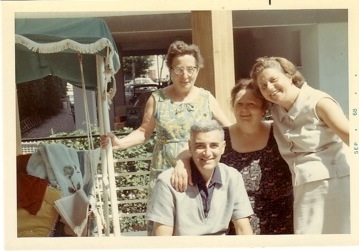
4 When did you first speak to her? How did you meet? How did you become friends?
My great desire was to meet her and know her in person. When she sang Missa Solennis in
Rome, at theTeatro Argentina, I went directly to the green room of the singers, bringing with me a
large and fine photograph taken during her 1938 Lucia at la Scala. She was there with Marga
Hoffgen and Petre Munteanu. I asked her to sign the photo with a dedication, I thanked her and
went away. This happened in 1954, but it was in 1965 that I had the opportunity to know her.
RAI broadcast from the radio a program called “Private record-libraries” and I was the first to open
it. I introduced a small group of singers, among them Caruso, Ponselle, Milanov, Bjorling,
Tetrazzini and, to offer a kind thought to my first voice teacher, Elda Di Veroli. The place of
honour was reserved to Lina Pagliughi and I stated firmly she had always been and still was my
favourite singer. My broadcast and the following ones sponsored by the most famous Italian
record collectors, had a great success, but I walked on air when I received a letter from
Pagliughi herself. In it she thanked me to have chosen one of her records (Serraglio Ah! Chi
amando era felice / Ach Ich liebte) and she had much appreciated all the explanations and the
singers. Here it is :
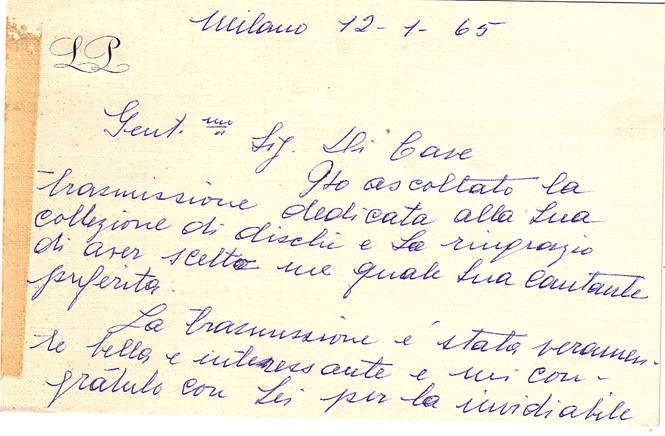
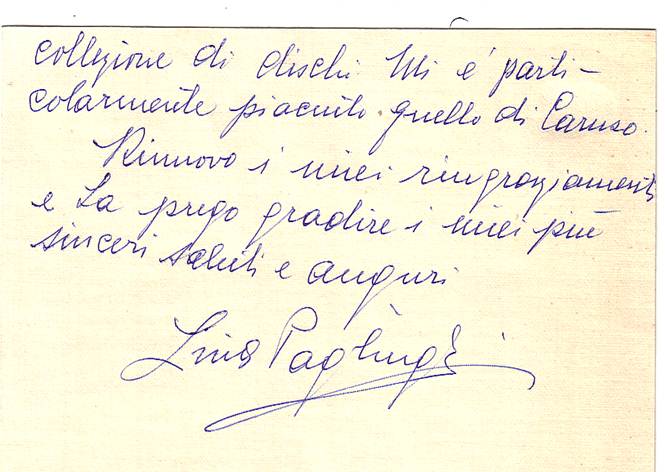
In 1966 my wife and I went to Gatteo where Pagliughi spent her Summer days and, at last, I could know her and her husband, Primo Montanari.
During the following Winter we went to Milano, where she had lived for many years, in Via Scarlatti, during the period of her activity and, in the Summer, again to Gatteo a Mare where she lived now in a new villa that replaced the previous building, which became too old. We went to visit her every year, but during the intervals we telephoned each other every week. It was really a pleasure to have a friendship with the soprano whom I had followed for so many years in the theaters and from radio and records and she was so kind to give me a copy of the vinyl records that Victor had sent to her.
After 1971 it was not possible for me to go again to visit her, but I spoke with her till two days previous her death. When her sister Flora – who was married to Montanari’s brother - telephoned to me to announce Mme Lina’s death I realized that we had lost not only the best voice I heard in my life but also a dear friend.
5 How was she as a teacher? How as a human being? How was her marriage?
I don’t know much about her as a teacher, I can say that in the summer she was very busy with a lot
of pupils. Dorothy Wilson, Wilma Driesen and Gianna Galli studied with her.
As a human being I think to have already said enough in my previous lines. She was very simple,
far from a diva and from a few words (I investigated very discreetly) I understood that
she had had a force of spirit and an iron will truly admirable. Her marriage was happy. Primo
Montanari was a worthy fellow, always ready to talk about opera and singers. I remember Mme
Lina ‘s despair when she told me of his death.
6 What did she think of the war?
During the years of the war Pagliughi sang in the theater and for the radio till the first month of 1944.
Then, with the intensification of air raids on Milan and Turin she retired first to Gatteo a Mare
with all her family. Soon after she fled to the mountains nearby to hide herself. In fact German
SS discovered that she was American born and feared she could be a spy!
Luckily she could come back to her house when Allied troops conquered Northern Italy.
She was very moved when I told her of my relatives who died in Auschwitz.
Lina spoke English very fluently, she had many friends in the USA and received visits from many of them. The first aria she sang for me was “Addio” by Tosti, in the English version. She kept always her American passport together with the Italian one.
7 Did she make a good fortune from her career? Was she in a good financial situation at the end?
Of course I cannot know much of her financial situation, but, judging from her life I can grant
that she had no financial troubles. She had always been a very wise woman and her older age was
serene.
8 Did she have any hobbies?
When Pagliughi knew I was a bookseller she told me she loved reading a lot, so, sometimes, I
sent her some good novels. The first I sent her was “Croce e delizia” by Milly Dandolo, a book
that dealt with music and singers.
9 I know you recorded with her. Was that for fun or did Eddie Smith ask for it?
Yes, I recorded with her, not at Eddie Smith’s suggestion. The first time I can say it was just for
fun and when Pagliughi told me to join her in the duet of l’Elisir d’amore she caught me
completely unprepared (and excited). The duets from Don Pasquale and Guarany ended up a
little better, but my aim was to invite her to sing and I succeeded, as I have now a good
collection of arias and songs. Till her sixties whe was still in good voice. It was a joy for me to have melodies she had never recorded, though many of them had appeared in her concerts.
The first song she sang for me was “Good bye” by Tosti.
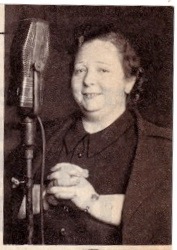
10. Why did she never sing at the Met?
It was inevitable that the Metropolitan Opera House would turn its attention towards this singer whom the critics never tired of comparing to Tetrazzini. It was thanks to Sol Hurok that she could audition for the Met with "'splendid" as the evaluation. Agreements were made for the next season; a contract was drawn up with much care but it proved useless: the time was not right; it was 1940 and Italy was preparing to go to war. At precisely that moment Primo Montanari was not with his wife; perhaps, had her husband been at her side, she might still have been willing to stay in New York, strong as she was from her latest success. But all those dear to her were on the other side of the ocean and, when her commitments had been fulfillled she hurriedly returned to Italy. She did have the time to record a few pieces for RCA VICTOR. “ (How many? We don’t know.)
It’s a pity that Met din’t engage her immediately for some performances of Lucia…
11. Luciano di Cave : I introduce here some comments to Pagliughi’s art and voice. Gianna Pederzini and Riccardo Stracciari had many flattering praises for her and Paolo Silveri spoke about her during a radio broadcast including in his program the duet from Traviata.
Tito Gobbi (in his book “My life” MacDonald and Jane’s – London 1979)
talking about the broadcast of Rigoletto with Pagliughi and Lauri Volpi: he (Lauri Volpi) greeted his Gilda, the heavy-weight but exquisitely voiced Lina Pagliughi…. Pagliughi (who had an excellent sense of humour)…. To deliver Gilda’s last farewell to life in that easy, beautifully coloured voice and with infinite pathos.
Giacomo Lauri Volpi (from “Voci parallele” Bongiovanni – Bologna 1977)
A candore e ingenuità si è ispirata una cantatrice che evidentemente ha plasmato se stessa a
immagine e somiglianza della Dal Monte: vogliamo riferirci a Lina Pagliughi. L’imitazione non
ha pregiudicato l’estensione e la qualità di questa voce, degna di menzione.
Gino Bechi (dal libro Gino Bechi – Il palcoscenico e la vita curato da Daniele Rubboli)
Bongiovanni – Bologna 1988
…In cartellone con lui (Bechi) la grande Lina Pagliughi…Cara, cara nobile Signora, sappia che
sempre la ricordo e con grande rispetto e affetto.
Gladys Swarthout (from The Last Primadonnas by Lanfranco Rasponi) London
Victor Gollancz LTD 1984
… of the coloraturas I would put Pagliughi first, despite my tremendous admiration for Lily
Pons’s admirable technique and discipline. I sang many Mallikas to Pons’s Lakmè and she was
The greatest perfectionist. But Pagliughi combined a marvelous purity with a warm timbre, which was miraculous.
Adelaide Saraceni (from The Last Primadonnas by Lanfranco Rasponi) London
Victor Gollancz LTD 1984
… Toti Dal Monte, Mercedes Capsir, Margherita Carosio… From my point of view, although
my admiration for all three was boundless, Pagliughi’s voice was the most beautiful and, in
certain passages, unequalled. If Lina had a different figure – she was enormous, because, I
believe, of some disfuncion of her glands, - she would have been number one.
Lia Pierotti Cei, daughter of M° Gino Marinuzzi (from La Scala racconta by Giuseppe
Barigazzi – in occasion of Mosè by Rossini - Rizzoli Milano 1984 )
The proportions of this light soprano (Pagliughi), already famous, were anything but light and the
Director (Mataloni) and his colleagues feared a negative reaction from the public. But my father
knew the ability of Pagliughi and would not be convinced otherwise: he knew no other singer
would be able to reach the high notes with such ease and was sure that after a few notes Pagliughi
would have won over the audience. Wrapped in a flowing mantle especially designed by the
costume designer, the soprano experienced a personal success
(The belt that adorned her dress was given toPagliughi by Luisa Tetrazzini who wore it in Lakmè)
Beniamino Gigli (Le memorie di Gigli – Mondadori 1957)
1923 … Mentre alcuni colleghi ed io stavamo attraversando la baia (San Francisco) sul
ferry-boat per prendere il treno che doveva portarci a Chicago, una ragazza sui sedici anni cantò
per noi delle canzoni italiane. La Tetrazzini l’aveva sentita cantare quando aveva quattordici anni
e l’aveva incoraggiata a studiare. Le feci i migliori auguri per il suo futuro e le chiesi di dirmi il
suo nome. Me lo ricordo ancora. Era Lina Pagliughi.
1937 … un concerto per il centenario di Gomes alla Scala, durante il quale fu con me Lina
Pagliughi, la ragazza che avevo ascoltato cantare sul ferry-boat di San Francisco nel 1923.
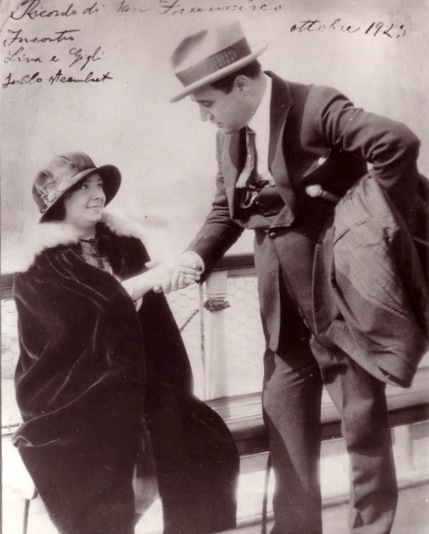
Carlo Maria Giulini – Il Sole 24 ore – January 21 2001
Lina Pagliughi aveva un fisico intollerabilmente ipertrofico perfino come valchiria, che le nocque
anche negli anni trenta, ma la sua Gilda immobile come un carro era tuttavia tenera e squillante.
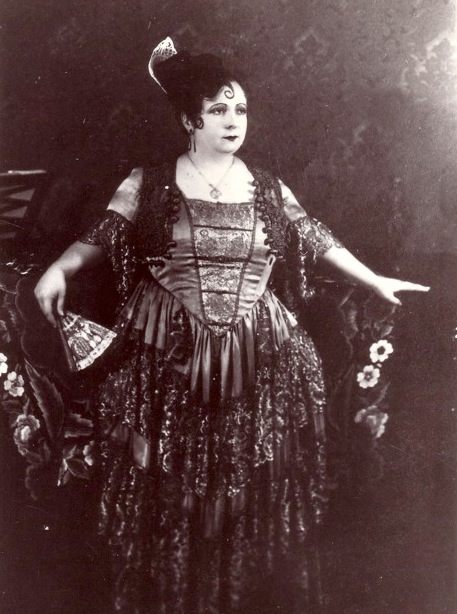
Click here to read about a three CD portrait
Click here to read about her on the website of the town where she lived